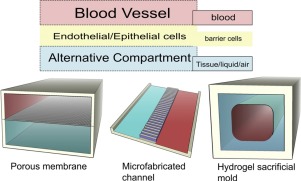Drug Discovery Today ( IF 6.5 ) Pub Date : 2018-01-31 , DOI: 10.1016/j.drudis.2018.01.036 Fang Yu , Nivasini D/O Selva Kumar , Deepak Choudhury , Lynette C. Foo , Sum Huan Ng

|
Microfluidic platforms have recently become popular as in vitro models because of their superiority in recapitulating microenvironments compared with conventional in vitro models. By providing various biochemical and biomechanical cues, healthy and diseased models at the organ level can be applied to disease progression and treatment studies. Microfluidic technologies are especially suitable for modeling biological barriers because the flow in the microchannels mimics the blood flow and body fluids at the interfaces of crucial organs, such as lung, intestine, liver, kidney, brain, and skin. These barriers have similar structures and can be studied with similar approaches for the testing of pharmaceutical compounds. Here, we review recent developments in microfluidic platforms for modeling biological barriers in the circulatory system.
中文翻译:

用于建模循环系统中生物屏障的微流体平台
由于与传统的体外方法相比,微流体平台在概括微环境方面的优越性,最近已成为体外模型的流行方法楷模。通过提供各种生化和生物力学线索,可以将器官水平上的健康和患病模型应用于疾病进展和治疗研究。微流体技术特别适合于建模生物屏障,因为微通道中的流量模拟关键器官(如肺,肠,肝,肾,脑和皮肤)的界面处的血流和体液。这些屏障具有相似的结构,可以使用相似的方法来测试药物化合物。在这里,我们回顾微流控平台的最新进展,以对循环系统中的生物屏障进行建模。











































 京公网安备 11010802027423号
京公网安备 11010802027423号